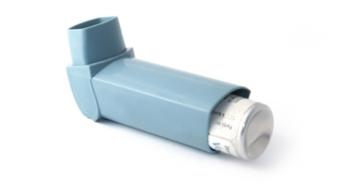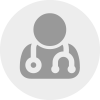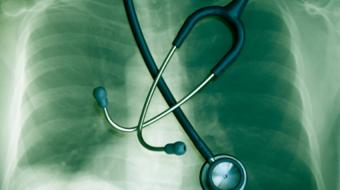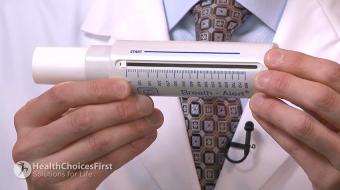Featured Videos
Premier Practitioners
All Videos
Chronic obstructive pulmonary disease (COPD) is used to describe chronic lung diseases, including bronchitis, refractory (non-reversible asthma) and emphysema. COPD has many causes, including smoking and genetic factors. If you have COPD, it’s important to see your physician regularly, because the disease is characterized by flare-ups and remissions.
Common COPD Treatments
The main treatment for COPD is a bronchodilator (inhaled medication). Other COPD treatments include:
- Oral steroids
- Phosphodiesterase-4 inhibitors (for severe COPD or chronic bronchitis)
- Antibiotics for respiratory infections
- Oxygen therapy
Patients with some forms of severe emphysema who aren't helped by medications alone may be candidates for surgery, including a bullectomy or lung transplant.
Lifestyle Modifications
There are also certain lifestyle changes you’ll need to make including quitting smoking, avoiding environmental pollutants, getting enough exercise, and eating a COPD-friendly diet.
Diet and COPD
Nutrition plays an important role in managing COPD and it's complications. Fiber and the macronutrient protein are very important as well as certain vitamins and minerals such as vitamin D, calcium, phosphorus, magnesium and sodium. Antioxidants, found in richly coloured fruit and vegetables, as well as omega-3 rich foods like salmon can also play a role in helping to reduce inflammation in the body.6.
Some individuals find the DASH diet an excellent plan to help reduce their sodium intake. The DASH diet stands for Dietary Approaches to Stop Hypertension. The DASH diet encourages whole grains, lots
of vegetables and fruit, nuts/seeds and legumes, lean meats and fish.
Here is an example meal plan:
Breakfast:
- 2/3 cup steel cut oatmeal with ¼ cup ground almonds and ¼ tsp cinnamon
- 1 cup mixed berries and 2 tbsp Greek yogurt
Lunch:
- Quinoa and bean salad – 1 cup cooked quinoa, ½ cup mixed beans, cucumber, green beans, red onion, shredded carrots, celery, balsamic vinaigrette.
- 1 cup cantaloupe
Snack:
- 1 cup seedless grapes and 1oz cheese
Dinner:
- Kale salad in lemon Caesar dressing
- 4oz grilled salmon
- Roasted cauliflower, sweet potato and white potato
- Baked apple in cinnamon
To learn more about the DASH diet click here.
COPD Complications and Nutrition
1. Breathlessness
Some patients experience breathlessness during or after a meal which can effect the ability or desire to eat. You can reduce or prevent this symptom by:
- Taking small bites
- Chewing slowly
- Eating smaller meals
- Drinking liquids after a meal, not during
- Clearing mucus from the airways before eating
2. Weight Control
Patients with COPD may be under or overweight depending on the individual. If you have chronic pulmonary obstructive disease and are underweight, you may need to find ways to add additional calories to your diet through things like nutritional shakes. If you’re overweight or obese, you may need to go on a low-calorie diet. If either of these situations apply talk to your healthcare provider about the right options for you.
3. Water Retention
Water retention can cause uncomfortable symptoms for people with COPD. Always check labels for the sodium content, and avoid adding salt to your food. If you want to add flavour, use herbs or salt substitutes.
4. Medications
COPD medications can interact with certain foods, especially caffeine and alcohol. Talk to your healthcare provider about your medications and possible interactions.
Left untreated, COPD can continue to get worse. In some cases, it affects patients silently, and it’s only later that it impacts their quality of life and leads to hospitalization or death. While there’s no cure for chronic obstructive pulmonary disease, if treated early and appropriately, many patients can maintain a good quality of life.
Talk to your family physician if you'd like more information on COPD.
Visit HealthChoicesFirst.com for more videos and resources on lung health.
Print this Action Plan and check off items that you want to discuss with your healthcare provider
-
Take a spirometry test to determine if I have COPD.
-
Review my current medications with my doctor to learn their effects on COPD.
-
Start a COPD-friendly diet to help manage my COPD symptoms.
-
Increase my physical activity by starting an individualized exercise program.
-
Quit smoking by following a smoking cessation program.
Adherence:
Adhering to your medications, prescribed exercises or lifestyle changes (such as dietary changes, smoking cessation, reduced alcohol consumption, etc.) is essential to improving health outcomes successfully. Compliance to any prescribed treatment is the number one thing you can do to ensure positive changes and optimal treatment outcomes.
Chronic obstructive pulmonary disease (COPD) is a lung disease characterized by chronic obstruction of lung airflow that interferes with normal breathing and is not fully reversible.







